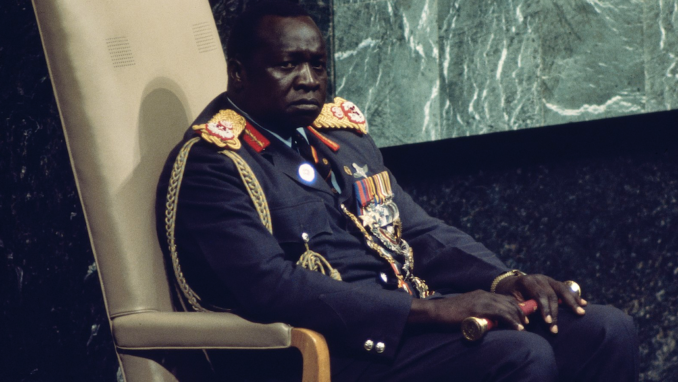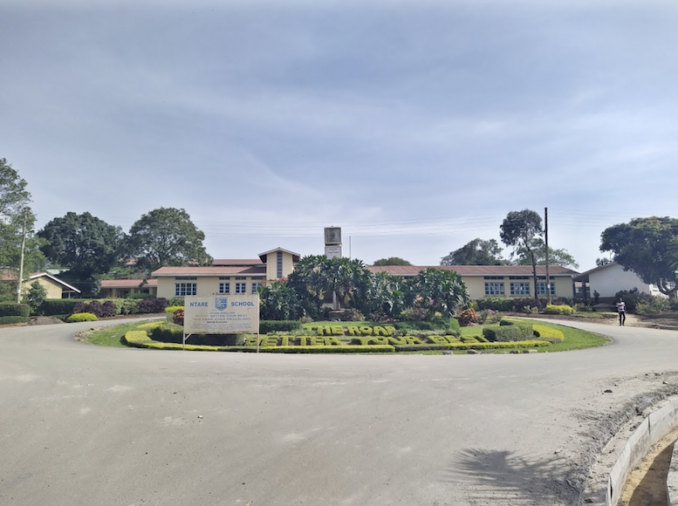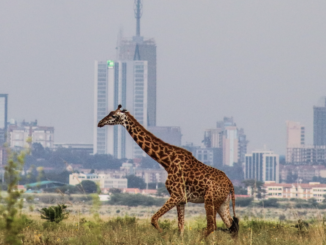
Idi Amin at United Nations (1975),
Bernard Gotfryd – Public domain
Obote depended on Idi Amin to enforce his policies, but knew he couldn’t trust his protégé. The suspicion was mutual. Hearing he was about to be arrested for the murder of an Obote ally, Amin struck while Obote was attending a Commonwealth meeting in Singapore in 1971, seizing control in a coup carried out with Israeli help. Amin, who was close to and was friendly with Colonel Baruch Bar-Lev, Israel’s military attaché in Uganda. Bar-Lev was eager to help Amin, who was serving Israel’s interests in Sudan, and he advised the Ugandan commander to form a battalion within the Army to protect himself. The Israelis would train it. This unit, consisting of paratroopers, tanks, and armed jeeps, proved instrumental.
The British Government was taken by surprise, but welcomed the development. The UK’s Foreign (and Colonial) Office (the Empire thinking remained paramount) had started worrying about Obote’s socialist leanings, and Amin, who was trained in the King’s African Rifles, was seen as an acceptable buffoon.
Amin’s first diplomatic visit was to Israel, followed by Britain, where he dined with Queen Elizabeth. But relations with both countries soon soured, especially after Israel refused to sell Amin fighter planes with which he hoped to bomb Tanzania, where Obote was then raising a rebel army.
Amin turned to Libya’s Muammar Qaddafi, who agreed to sell jets to the Ugandan, but only if the latter would break off ties with Israel. Amin promptly expelled all Israelis from the country, installed the PLO in the former Israeli Embassy, and commenced construction of a giant mosque in downtown Kampala. He then telephoned his foreign minister, an elegant barrister and tribal princess named Elizabeth Bagaya, and asked her to draft a cable to Prime Minister Golda Meir that read, “Pick up your knickers and go back to America where you came from!”
“I’m sorry, sir,” Bagaya replied, “but you’re a head of state, and as such you cannot use such language.” Amin hung up on her, but the cable was never sent.
But “Dada” (Big Daddy) however, wasted no time showing his ruthless side. Acholi and Langi forces, assumed to be loyal to Obote were massacred in their barracks and replaced by Nubians, former rebels from South Sudan, and members of Amin’s Kakwa community. In Uganda, knowing someone’s ethnic identity was to know their politics.
Briefly, Uganda’s Banyarwanda found themselves on the winning side of history. Amin required legitimacy and as a strategy he encouraged various minorities in order to expand his political base. An invitation to Rwanda’s exiled Mwami, King Kigeli V to rebase himself in Uganda was part of Amin’s courtship.
Hungry for protection and blessed with impressive educational qualifications, the Banyarwanda swelled the ranks of Amin’s State Research Bureau, the military intelligence agency which became synonymous with torture and indiscriminate murder. It did them few favours. As Amin euphoria began to wane, the community acquired a reputation for being secretive and aloof.
Amin passed a decree giving his soldiers the power to arrest anyone suspected of sedition, and they applied it with enthusiasm, behaving as though occupying a foreign country, which was how many of them viewed the situation.
Amin also presided over a full-blown economic catastrophe. In 1972, Amin ordered all Asians who had not taken Ugandan nationality to leave the country. His move won considerable approval in the country because many Africans believed they had been exploited by the Asians, who controlled the middle and some of the higher levels of the economy, but the action isolated Uganda from the rest of the world community. Although a few wealthy Ugandans profited from Amin’s actions, the majority of the commercial enterprises formerly owned by Asians were given to senior army officers who rapidly squandered the proceeds and then allowed the businesses to collapse.
Every crisis also provides an opportunity and some benefitted from Amin’s quixotic rule. Amin’s disastrous “Africanisation” programme meant many Banyarwanda, many got places in either Old Kampala Senior Secondary School in Kampala, or in Kagame’s case Ntare School (one of the best in Uganda and also M7’s alma mater) in Mbarara.

Ntare School in Mbarara, Uganda,
Kateregga1 – Licence CC BY-SA 2.0
Kagame was finding it tough going. Having done so well a Rwengoro Primary School, at Ntare his grades began to slide, as his status as a refugee began to register. No longer the dutiful class monitor who got a kick out of enforcing school rules, he ended up being suspended for fighting with pupils he accused of picking on refugees. He had already got a reputation as a troublemaker, a boy with problems. Kagame left school with poor grades. He tried to retake his final year but an aunt he approached refused to pony up the required funds. His refugee status collapsed his dream of studying in Switzerland and becoming a pilot.
Frustrated, he joined thousands of unemployed on the Kampala streets, selling goods bought upcountry to city dwellers for a small markup; trading in gold, foreign exchange and travellers’ checks, and close to entering the criminal world. Frustrated and annoyed, he was a perfect recruit for any political movement promising change.
Opportunity Strikes
Kagame’s boyhood friend, Fred Rwigyema surfaced in Fort Portal, western Uganda, offering him the chance. Fred had undergone a transformation. He had joined the Front for National Salvation (FRONASA), a group set up by a Marxist political activist M7. While Kagame had floated around Kampala doing nothing, Fred had trained in Tanzania and Mozambique, where he learned how to handle a gun. FRONASA had just taken part in an operation of which Kagame lapped the details up.
For a young M7, neither Obote nor Amin was Uganda’s real problem. The entire system set up by colonial powers, with ethnic factionalism and religious sectarianism, needed to be removed. Having shown an early interest in politics, he attended the University of Dar es Salaam, where Tanzanian President Julius Nyerere’s socialist ideas held sway. The independence generation of African leaders, he concluded, was politically bankrupt, exploiting differences for personal gain, incapable of national unity. Armed revolution, not the democratic process, was the answer.
He’d visited North Korea, learned how to handle a gun, set up a revolutionary student group in Tanzania, and arranged for a group of fellow cadres to receive military training from the Mozambique Liberation Front (FRELIMO), which taught, among other things, the importance of small guerilla movements avoiding head-on military confrontation and the merits of a protracted war.
His FRONASA group wanted to get rid of Amin and saw Obote as no improvement, but it faced a big problem. M7 depended on Nyerere for support, guidance and FRELIMO connections, and Nyerere wanted Obote, who he granted sanctuary, returned to power. M7 kept quiet and focused attention on getting his fighters properly trained, buying weapons and establishing secret cells across Uganda.
In September 1972 Obote’s “forces” together with FRONASA participated in an abortive invasion. The Organisation of African Unity (OAU) condemned the attempt and Nyerere was obliged to sign a peace agreement with Amin recognizing his regime. M7 could no longer count on the indulgence of Tanzanian authorities, so he got married and became a teacher in Moshi, northern Tanzania.
In 1976, he was ready to re-enter the game. Setting off for Mozambique with a group of fighters whose training he intended to personally oversee. The group, which included Fred and M7’s own much younger brother Salim Saleh, would eventually form the core of what became the National Resistance Army (NRA).
In October 1978, Amin, now paranoid, fell into a trap of his own making. He’d sent troops to seize Tanzanian land running along the Kagera River, which he claimed belonged to Uganda. Amin had provided Nyerere with the excuse he needed to rid himself of the erratic neighbour. Post recent acquisitions of Soviet jets, missiles and artillery, the Tanzanian army counterattacked together with Ugandan anti-Amin Ugandan groups that united under the banner of Uganda National Liberation Army (UNLA). A contingent of Libyan troops sent by Gaddafi to Amin’s rescue found themselves alone on the line of contact, as retreating Ugandans focused on the more interesting job of looting.
On 11th April 1979, the Uganda-Tanzania war was over, Amin had fled, eventually finding safe haven in Saudi Arabia. M7’s FRONASA force had swelled to 9,000, was named Min of State for Defence in the new government, and a military commission set about returning Uganda to civilian rule. M7 played along, but never bought into the approach. As far as he was concerned, the job of transforming Uganda’s politics was only half done.
Within months, ethnic rivalry and mutual suspicion ensured the constituent parts of Uganda’s anti-Amin coalition were at each other’s throats. Demoted to Minister for Regional Cooperation, M7 refused to proceed further when he discovered that the young Banyarwanda, he’d recruited to FRONASA, including Fred, one of his best fighters, were being systematically disqualified from joining the UNLA on the grounds of nationality. Aware the ground was being cut from under his feet, M7 quietly prepared to return to the bush. With him would go both Fred and Kagame, who, inspired by his friend’s example, had by then completed a seven-month Tanzanian course in espionage and information-gathering.
In May 1980, Obote returned to Uganda, and elections, the first in 18 years, were set for December. M7 was one of many Ugandans to regard polls that followed as a pointless farce. Sure enough, Obote’s UPC claimed victory, and Uganda embarked on Obote 2.
Tanzanian soldiers who had come as liberators, turned into smiling, sadistic, killers. Owning watches, sunglasses, TV sets and radios became death sentences. The city’s discos and nightclubs closed at noon, since shootings would start mid-afternoon continuing until the following morning. Amin had gone but Kampala felt even less secure.
With the support of the International Monetary Fund and other external donors, Obote tried hard to rebuild the economy. Initially his efforts seemed successful, but the extraordinary inflation rate resulting from an entrenched black-market system worked against him.
It was impossible for urban wage earners to keep pace with rising prices, and salaried civil servants grew frustrated at the government’s inability to increase their pay in line with their needs.
The main problem M7 faced, thanks to UNLA’s demobilisation programme, was an acute shortage of weapons. If his initial number of would-be guerrillas was small (34), weapons were in shorter supply (27 – the Ugandan famous 27 guns).
M7’s new guerilla movement entered the public domain on 6th February 1981, an attack on Kabamba, a military barracks 3½ hours drive west of Kampala, the agenda get some guns.
M7 had studied Uganda maps in detail, working out where his guerilla movements needed secret cells, certain locations kept popping up. One location kept popping up, Makerere University was always one of the names. Within the region, a cell was run out of a safe house in Nairobi. As a conduit it was used connecting would-be recruits to its organisers. Wannabe guerrillas would cross the frontier, gather at agreed collection hubs. If judged suitable, be smuggled back into guerilla strongholds in Uganda and taught how to fight.
It inevitably drew the Ugandan authorities’ attention. This was the era of “panda gari” (Kiswahili for get into the car), Obote’s security services toured the streets, loaded “suspected” sympathisers into pickup cars, driven to interrogation centres which they never emerged.
The famous “Computermen” – undercover agents, would loiter around campus gates, whipping away students, whose battered bodies would later be discovered, decomposed in forests on the outskirts of the city.
© AW Kamau 2023



